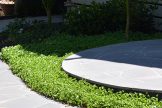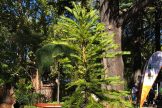
Vast expanses of patchy, dead and weed infested lawn areas taking up space in your backyard? Are you a slave to the drone of a lawnmower on your day off? Instead you could be out in your garden enjoying your own private space, a space tailored to your needs and aesthetic style. Escape the mundane uniformity of an artificial, vegetative mat and enjoy some of the visual and aromatic delights the natural world has on offer. You are only limited by your imagination when it comes to finding an alternative for all that dull lawn.
When you finish reading this page, don’t forget to take a look at our list of Lawn Alternative planting ideas as well as a rundown on the fantastic Plant Tiles.
Lawn Alternative Planting Options
Less maintenance
Mowing, edging, fertilising and weeding of lawns require more time and maintenance than well chosen ground covers, planted garden beds, mulched, gravelled or paved surfaces. Lawns, being in essence a single species, are more susceptible to pest and disease attack. The problem is compounded by the fact that large expanses of lawn provide little interest to a diverse array of insects, birds and animals that may keep pest problems at bay, not only on your lawn areas but in other areas of the garden such as the vegie patch.
Mowing vast expanses of lawn also contributes to greenhouse emissions, as well as the physical energy used.
Less water
Although under current water restrictions there is no watering of lawns with mains water, even the tougher species of turf grass will require some form of supplementary watering through summer to look their best. Alternatively there are many ornamental plant species which will maintain good vigour with no supplementary water once established.
Increase biodiversity
Increasing the number of species not only contributes to a more interesting and visually rewarding landscape, but helps to combat the “green desert” phenomenon that is a lawn. Attract native wildlife into your garden with many butterfly, bird and insect attracting plants. This will help to reduce of eliminate the need for using sprays to control pest and disease problems in the garden. As Melbourne expands and sprawls ever outward, more indigenous species are being lost.

So what can I plant instead?
We have put together a list of planting options to get you started. Click here to view some pictures and information on a whole bunch of interesting lawn alternatives.
Reasons you may not need a lawn at all
- Shady dry areas under trees
- Areas unlikely to be walked over, played on etc.
- Small or awkward areas
- Areas with significant slopes
Lawn Alternatives
If you like the open feel of a lawn but don’t want the maintenance or water requirements, consider the following options…

No Traffic
No traffic open spaces allow for some of the greatest flexibility in style and plant choices.
Widen Garden Beds
This is probably the first and most easy step. Increasing the width of garden beds allows for a greater volume of soil, and greatly increases the potential for holding water and nutrients essential for healthy root growth. Not only will the plants growing in a wider garden bed be more healthy and require less supplementary water to maintain, but a greater visual sense of depth is created. You will also be able to grow larger plants successfully, giving you a much expanded choice of plants. It may be as simple as cutting a wider bed out of the lawn or removing a course or two of bricks. When putting in garden beds along fence lines around a lawn try to make them at least 1.5 m wide or wider. Plant wide beds with a layered effect to achieve this sense of depth. Soften hard edges with groundcover plants and ornamental grasses and allow shrubs and trees to retain lower branches (just mow around them or carefully under them).
Using ornamental grasses
Ornamental grasses are a great alternative in areas where there is no traffic and there are hundreds of native and exotic varieties to choose from. Massed planting of the one species is visually effective and fairly easy to maintain particularly if the density is right. Utilising the textural qualities of grasses in a mixed planting, whilst taking a little more effort to maintain, is visually very appealing. The features of ornamental grasses that can be used include their habit (tall, short, strappy, grassy, arching, spiky, tufting, architectural), their foliage colour, flower colour and seed heads. Other plants that may be combined successfully with ornamental grasses are herbaceous perennials, small open shrubs, groundcovers, and bulbs.
Planting on slopes
On slopes choose plants that have soil binding characteristics and are fast growing. Many ornamental grasses, groundcovers which have suckering, rhizomatous or stoloniferous growth (that is they put out roots along their stems), and some climbing plants are suitable choices.
Meadow “Lawn” areas
These are areas planted out with a mix of grasses and perennials allowed to grow to their full height without mowing. A mass planting is effective particularly with paths mown between. Ideally, try a mixture of indigenous grasses, lilies, wildflowers and ground covers. Don’t mow… often. To encourage flowering and growth of the meadow it is recommended that the area be cut twice a year using a brush cutter. The optimal times to cut the meadow is in early summer after spring flowering and late autumn. The cut material should then be removed and composted.
Light Traffic
Using mulch as a replacement to lawn
This works most effectively as a usable open space when yards are landscaped with the taller plants at the edges and layered down to an open mulched space in the centre. Soften the transitional space between the taller elements and the mulch with small shrubs, perennials, groundcovers and ornamental grasses.
If an open expanse is not required then mulch can be used under trees, effectively creating a miniature wood with groups of small trees or tall shrubs with a simple covering of mulch and selected groundcovers, bulbs and ornamental grasses as an under story.
Areas under established shrubs and trees can be mulched and this will help to improve the health and vigour particularly in periods of drought. There are so many mulch materials to choose from, so choose for function, but also for aesthetic reasons.
Using groundcovers as an alternative to lawn
Areas that are traditionally difficult to establish lawn perform well with many alternatives. Regions such as under large trees of near eves can be given a new lease of life with the addition of low water and light requiring ornamental grasses and groundcovers.
In areas of light traffic it is necessary to choose plants that are tolerant of small levels of disturbance. Plants that are used should be flexible and low lying. This will allow them to bounce back when trodden on. Solid groundcover lawns will only take very light foot traffic and will take some effort in establishing them, particularly with regard to weeding.
For Heavy Traffic use the same varieties as those for areas with light traffic, but with the addition of stepping stones or paths. You could choose a single species, or for greater interest try a patchwork of species. This takes a little more planning but can result in a spectacular display. Groundcover species can provide you with colour from foliage, flowers and seed heads, scent from crushed foliage or flowers, and textural interest. If using flower colour select groundcovers which have a similar flowering times in the same area for added impact. The space can be completely covered by plants or with mulched spaces between.
Paths can simply be of the same mulched material as the rest of the area or formal paths of gravel may be laid. If using stepping stones there is a plethora of options available. The stepping stones can be surrounded by mulch, groundcover or a coarse permeable material. Prepare the site under the stone making sure it sits level, (a compacted crushed rock base would be ideal).
Gravel and Paved Surfaces
Paving large areas increases run off, reduces the amount of water passing through to the soil and increases the temperature of your back yard in summer. For these reasons alone, you should think carefully before covering large expanses of lawn with a paved solid paved surface. Keep the solid paving to a minimum, such as entertainment areas and heavy traffic areas like driveways and entrance paths.
Consider the slope of the paving to direct run off into surrounding garden beds. More permeable surfacing materials are preferable, such as gravels and coarse sands. Pebble areas can be very time consuming to maintain a weed free space, so keep these to a minimum. Solid pavers can be set apart with coarse material or suitable light traffic groundcovers planted in between. This helps by increasing the permeability of the surface and by keeping the temperature down in summer.
Don’t forget to take a look at our list of Lawn Alternative planting ideas. Click here for pics and more info.





